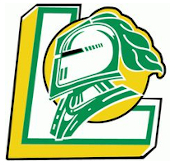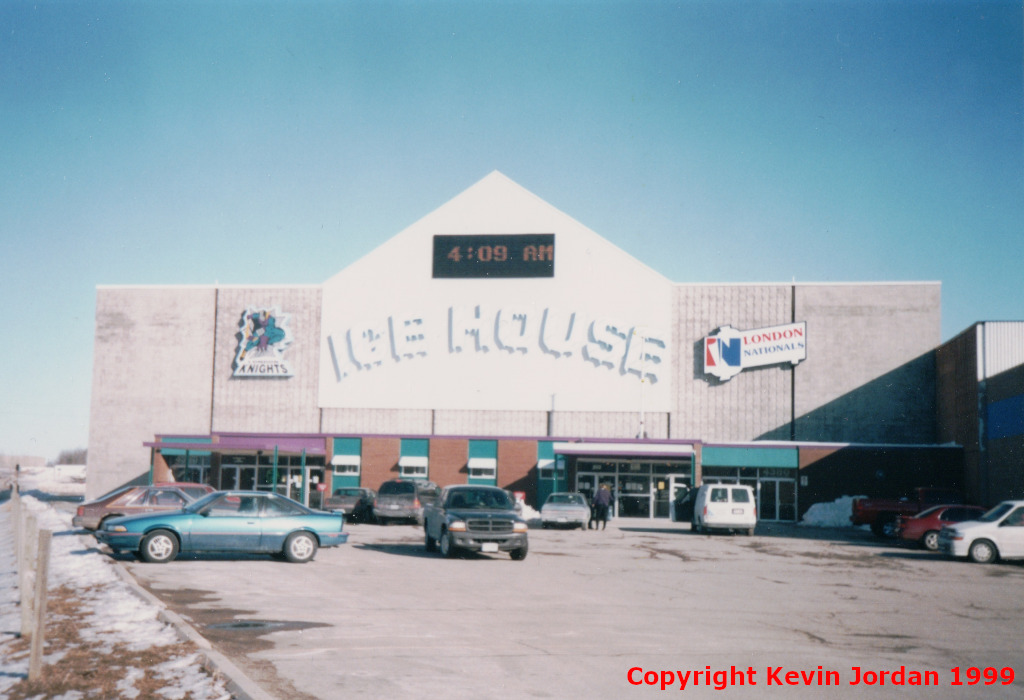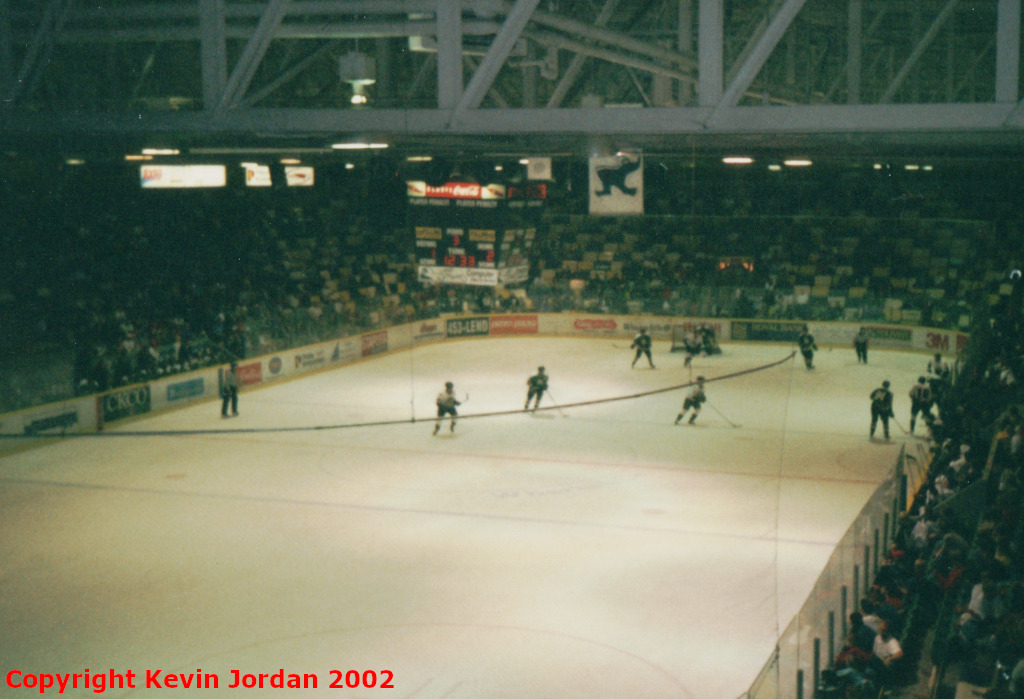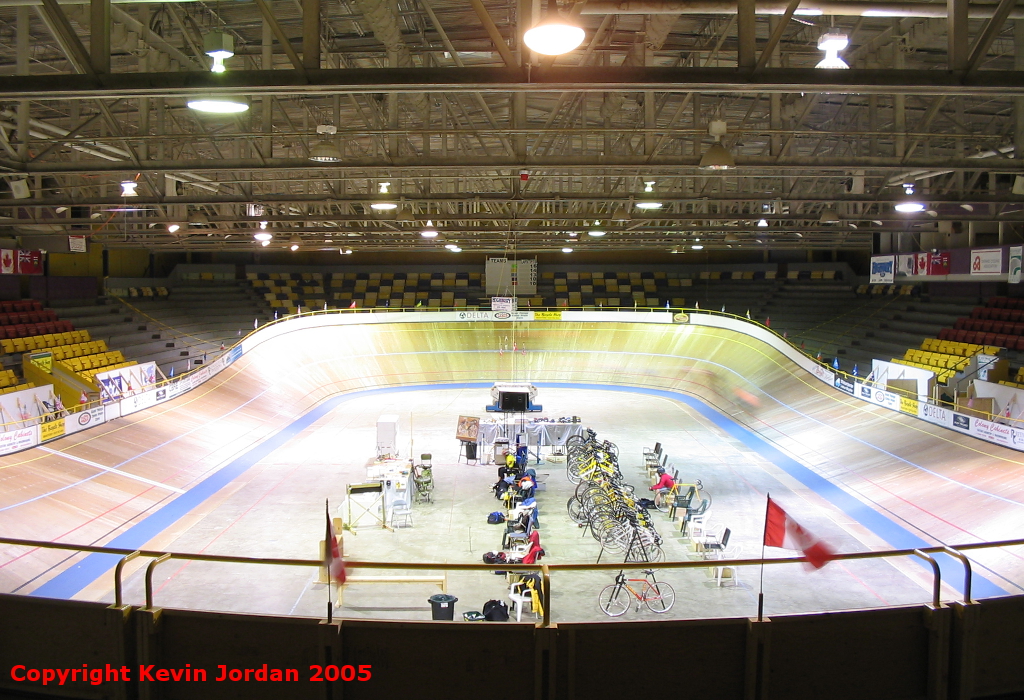
London Knights
Arena Name: London Gardens, aka London Ice House
Capacity: 5,075 (4,680 seated)
Built: 1961-64
Last Game: 2002
Current Use: Cycling Velodrome
Address: 4380 Wellington Road South, London, ON, N6E 3A2
Ice Surface Size: 190' X 85'
Velodrome Web Site: ForestCityVelodrome.ca

London Gardens

What Was the Arena Like?
First Visit: November 20, 1987
CHL Arena: 1
OHL Arena: 1
I grew up in the White Oaks subdivision of London. In the 1980's, White Oaks was the southern edge of the city, and both of my childhood homes were within a few blocks of the London Gardens, home of the Knights. My Dad took me to my first game on Nov. 20, 1987 against the Guelph Platers. It ended in a 3-3 tie, and I can still remember to this day seeing adults shouting and making noise - something I'd never seen before - as well as the dazzling white and green of the Knights' uniforms and the menacing black and red of the visitors. I loved it so much that we started going regularly, and by the time I started working part-time as a teenager, one of the first purchases I made with my newly-found disposable income was a Knights' season ticket ($181 for student pricing in 1999!). Between 1999 and 2002, I barely missed a game, watching from section 17, row E, seat 1 - a place that no longer exists in the current building.
The last game ever played at the London Gardens was a preseason game in September of 2002, and appropriately-enough, it was against the Platers/Attack franchise and ended in a tie. The Gardens still stands today in a slightly run-down plaza in south London, easily visible from the 401. New ownership converted it to a cycling velodrome a few years after it closed, and while I haven't been in the building since 2012, the last time I visited felt like seeing a beloved grandparent in slow, sad decline. Waterproof tarps guarded against multiple roof leaks damaging the wooden velodrome surface, and paint was peeling off the walls everywhere you looked. Most of the seats have been removed - the plastic 1994-vintage seats from the sides were sold to Windsor Arena and presumably are still there, where the old wooden benches were mostly sold off at auction. What remains has been moved to the "centre ice" section for a view of the velodrome.
You wouldn't know it to look at it now, but there was a time when the London Gardens was the most important sporting building in London. London is not and never has been a great sports town, but we've always been a great Knights town, and the team was supported through thick and (mostly) thin for its 37-year tenure in south London. Personally, I miss the place more than I can tell you. It smelled of ammonia and sweat and stale popcorn. And it had fans who had been sitting in the same seats for thirty years and knew each other intimately, terrific hecklers, an 80-year-old man making announcements over the garbled sound system, and among the best hockey atmospheres in Canada. It was old-time hockey personified, and I feel grateful that I got to watch hockey there for fifteen years while growing up.
As an arena, the Gardens was nothing special. It was a cinder-block box attached to a strip mall, with a massive gravel parking lot behind it. It had an understated 1960's homeyness to it, but it wasn't by any means a beautiful building. The building had a "U" shaped concourse area under the seats where the washrooms and concessions were located, while the seating area was designed with the "4-corners" scheme popular in the 1960's. The entry to the seats was from the top concourse. The Gardens was painted in gaudy colours - back in the 1980's everything was in the tasteful team colours of bright green and yellow, but after the Knights' ill-advised colour change in the mid-90's, some things were changed to purple and teal, and the former green was repainted in blue in support of a proposed Colonial Hockey League team that never actually materialized. The end result was you had a building with fluorescent yellow walls, blue, yellow and white seats, and purple and teal accents everywhere. The seating area had newer plastic seats on the sides and older two-man benches in the ends. There were about 15 rows of seats, and the angle was steep. Longtime Knights' trainer Don Brankley made his home in the Gardens under the seats in a small apartment next to the Knights' dressing room. For years as well, the Knights had a retro Zamboni - they owned one model from the 1950's and another from the early 1970's, both of which had the old chain sweeping system. As a child, I thought they were the coolest things I had ever seen.
I saw over 250 games at the London Gardens and I felt like I knew the place as well as my own home. It was raucous, loud, and had the atmosphere of a madhouse. The paint was peeling, the toilets were few and far between, the seats were uncomfortable and the lighting was terrible, but it was a fantastic place to watch a game, with an atmosphere that new buildings could never duplicate. You sat right on top of the action and the players could practically hear whispers coming from the crowd.
The Gardens has been a velodrome for over a decade now, and a large part of me is very glad that the old building is being used productively as the rest of the former Superstore Mall declines into irrelevance around it. The arena's future seems secure and it's in no danger of being demolished any time soon. But again, I miss the ritual of going to games there. From my childhood home we could drive to the rink in five minutes on game nights, and I miss seeing the same faces in the parking lot, in the cramped concourse, and in the seats. I miss the days when the team was unfashionable and had 3,500 diehards attending every game because they loved hockey, not because it was the trendy thing to do. Most of all, I miss the atmosphere. I travel now to experience what it's like watching junior hockey from a terrific seat hanging over the ice while thousands of fans scream and cheer and sing, because in my hometown, that's become a thing of the past.
No Londoner would ever begrudge the building of the Budweiser Gardens downtown - the revitalization of Downtown London is a direct result of the arena's construction, and we get major concerts now - but it came at a price, and that price was the ability to watch hockey the way it was meant to be watched. I have absolutely no issue with the fact that my team is now successful, and London, the fourth-largest independent city in Ontario, needed a bigger and more centrally-located arena. But we lost something irreplaceable in 2002, and I miss it more than I can tell you.
Inside London Gardens

What's the Arena Used for Today?
In 1961, Highway 401 had recently been completed along the southern fringe of the city of London. The city hadn't yet expanded south enough to envelop the land where the highway sat - which is part of why it went where it did - and so technically, the Treasure Island Mall, which opened that same year, sat in Westminster Township. At that time, London's only spectator arena with permanent ice was the ancient, run-down Ontario Arena at the Western Fairgrounds, and seeing a market need, the developers decided to include a 5,000 seat hockey arena in the plans for their new mall. Unfortunately, the developers went bankrupt partway through construction, and the half-finished arena, just a mass of girders, sat empty for four years.
In 1964, the project was finally finished and the Treasure Island Gardens opened with an NHL exhibition game between Boston and Toronto. The arena was designed to be a one-level copy of the Boston Garden. There was also a second ice pad connected to the building at the time, but it was eventually closed and the space today is part of what was the United Furniture store next door (you can tell the building's arena past by the arched roof trusses and the lack of interior support columns). For its first year the arena was only home to the junior B London Nationals due to the dispute between the OHA and the Toronto Maple Leafs in the wake of the Metro League fiasco; the Leafs wanted a second sponsored junior team in London to replace the folded St. Michael's Majors, while the OHA wouldn't allow it at first. It took a year's lobbying before the OHA relented, and the Nats finally were promoted into Junior A in 1965. The team itself had a history dating back to 1951, playing at the Western Fairgrounds and winning the local junior B championships a couple times in the 50's and 60's.
In 1968, the era of NHL ownership ended and the team was sold to Howard Darwin, who renamed the team "London Knights" and changed the colours to green and gold. The arena was also renamed the London Gardens after four years of pirate jokes had started to wear thin.
The arena was home to a lot of the city's history over the years. The Rolling Stones played the building on their first North American tour in 1964, and the cops shut down the concert after 15 minutes. Alice Cooper, Randy Travis, AC/DC, the WWF and Bill Cosby are just some of the names who played the venue over the years. The Gardens' most famous concert moment, though, came in February 1968 when Johnny Cash proposed onstage to June Carter, who would remain his wife right up to her death in May 2003.
One unfortunate characteristic of the Gardens, though, was that the building was never really maintained over the years. The arena was the only wholly privately-owned arena in the CHL, and the Knights, in that mom-and-pop era of junior hockey, never had the money to properly maintain the arena. In 1991, the city of London annexed Westminster Township (it is worth noting that the Knights didn't actually play in London until 1991!), and that resulted in the land being reassessed for property tax at city rates, which dramatically increased the team's costs. I am told that the Knights' decline in the 1990's is not entirely coincidental to this.
In 1994 the Knights were bought by real estate mogul Doug Tarry Sr., who died mere months after. His hockey-ignorant son Doug Jr. took over the team, and it was he who changed the Knights' colours to awful eggplant and teal, the logo to "Spiderknight" and renamed the building "The London Ice House." Tarry was going for a total image change, but the changes were silly at best, and true London fans still bled green and gold. As a part of lobbying the city for a new arena, the Tarry group also stopped booking any supplemental events at the arena, so regular tenants like the London Auto Show and the Garden Bros. Circus as well as occasional concerts completely ceased.
In 2000 the Brothers Hunter, ex-NHLers Mark and Dale, bought the Knights along with minority partner Basil McRae. With new ownership on board, the city relented, and plans very quickly were afoot to build the new John Labatt Centre (today the Budweiser Gardens) on the Talbot Block in downtown London. In February 2002 the Knights' colours were finally changed back to green and gold. The eggplant and teal period today seems like a bad dream, and no matter what the Hunters do to the team, they will always be remembered as the men who brought back the green and gold.
In the fall of 2002 the Gardens finally closed as the Knights moved to new digs in downtown London. One of the team's last acts with the old building was to sell the 1994-era plastic seats to the Windsor Arena, where they still can be found. The Hunters sold the arena to new ownership on the condition that the arena could never have an ice surface placed back in it, and the ice-making plant was dismantled before the building was sold. The "London Motoplex" was the arena's first post-hockey use, which was North America's only permanent indoor motocross facility with stadium seating. Several hundred tons of dirt were dumped on the arena floor and dirt bikes jumped where the Knights once skated. The arena was completely unchanged with the exception of a few rows of seating in section 17, which were removed to allow the dump trucks full of dirt easier access. (Including my old season ticket seat, the bastards.) However, the dire predictions came true a mere six months later as the Motoplex filed for bankruptcy. The building was then bought by a local businessman called Gurmit Grewal, owner of London Carrier, Inc., who intended to convert the old rink into a garage for his fleet of trucks. However, before this could be done, Grewal sold again, and the arena was converted in spring 2005 into one of North America's only indoor cycling velodromes. The former parking lot behind the building on Castleton Road - prime industrial land - was sold off separately around that time, and is today home to a factory called OTC Group.
The adjoining Superstore Mall, formerly the Treasure Island Mall, was a dead mall even when I was young, and it was finally demolished in the summer of 2019. The Gardens and adjoining B-pad building still stands, and one hopes they remain open for long into the future.
In 1964, the project was finally finished and the Treasure Island Gardens opened with an NHL exhibition game between Boston and Toronto. The arena was designed to be a one-level copy of the Boston Garden. There was also a second ice pad connected to the building at the time, but it was eventually closed and the space today is part of what was the United Furniture store next door (you can tell the building's arena past by the arched roof trusses and the lack of interior support columns). For its first year the arena was only home to the junior B London Nationals due to the dispute between the OHA and the Toronto Maple Leafs in the wake of the Metro League fiasco; the Leafs wanted a second sponsored junior team in London to replace the folded St. Michael's Majors, while the OHA wouldn't allow it at first. It took a year's lobbying before the OHA relented, and the Nats finally were promoted into Junior A in 1965. The team itself had a history dating back to 1951, playing at the Western Fairgrounds and winning the local junior B championships a couple times in the 50's and 60's.
In 1968, the era of NHL ownership ended and the team was sold to Howard Darwin, who renamed the team "London Knights" and changed the colours to green and gold. The arena was also renamed the London Gardens after four years of pirate jokes had started to wear thin.
The arena was home to a lot of the city's history over the years. The Rolling Stones played the building on their first North American tour in 1964, and the cops shut down the concert after 15 minutes. Alice Cooper, Randy Travis, AC/DC, the WWF and Bill Cosby are just some of the names who played the venue over the years. The Gardens' most famous concert moment, though, came in February 1968 when Johnny Cash proposed onstage to June Carter, who would remain his wife right up to her death in May 2003.
One unfortunate characteristic of the Gardens, though, was that the building was never really maintained over the years. The arena was the only wholly privately-owned arena in the CHL, and the Knights, in that mom-and-pop era of junior hockey, never had the money to properly maintain the arena. In 1991, the city of London annexed Westminster Township (it is worth noting that the Knights didn't actually play in London until 1991!), and that resulted in the land being reassessed for property tax at city rates, which dramatically increased the team's costs. I am told that the Knights' decline in the 1990's is not entirely coincidental to this.
In 1994 the Knights were bought by real estate mogul Doug Tarry Sr., who died mere months after. His hockey-ignorant son Doug Jr. took over the team, and it was he who changed the Knights' colours to awful eggplant and teal, the logo to "Spiderknight" and renamed the building "The London Ice House." Tarry was going for a total image change, but the changes were silly at best, and true London fans still bled green and gold. As a part of lobbying the city for a new arena, the Tarry group also stopped booking any supplemental events at the arena, so regular tenants like the London Auto Show and the Garden Bros. Circus as well as occasional concerts completely ceased.
In 2000 the Brothers Hunter, ex-NHLers Mark and Dale, bought the Knights along with minority partner Basil McRae. With new ownership on board, the city relented, and plans very quickly were afoot to build the new John Labatt Centre (today the Budweiser Gardens) on the Talbot Block in downtown London. In February 2002 the Knights' colours were finally changed back to green and gold. The eggplant and teal period today seems like a bad dream, and no matter what the Hunters do to the team, they will always be remembered as the men who brought back the green and gold.
In the fall of 2002 the Gardens finally closed as the Knights moved to new digs in downtown London. One of the team's last acts with the old building was to sell the 1994-era plastic seats to the Windsor Arena, where they still can be found. The Hunters sold the arena to new ownership on the condition that the arena could never have an ice surface placed back in it, and the ice-making plant was dismantled before the building was sold. The "London Motoplex" was the arena's first post-hockey use, which was North America's only permanent indoor motocross facility with stadium seating. Several hundred tons of dirt were dumped on the arena floor and dirt bikes jumped where the Knights once skated. The arena was completely unchanged with the exception of a few rows of seating in section 17, which were removed to allow the dump trucks full of dirt easier access. (Including my old season ticket seat, the bastards.) However, the dire predictions came true a mere six months later as the Motoplex filed for bankruptcy. The building was then bought by a local businessman called Gurmit Grewal, owner of London Carrier, Inc., who intended to convert the old rink into a garage for his fleet of trucks. However, before this could be done, Grewal sold again, and the arena was converted in spring 2005 into one of North America's only indoor cycling velodromes. The former parking lot behind the building on Castleton Road - prime industrial land - was sold off separately around that time, and is today home to a factory called OTC Group.
The adjoining Superstore Mall, formerly the Treasure Island Mall, was a dead mall even when I was young, and it was finally demolished in the summer of 2019. The Gardens and adjoining B-pad building still stands, and one hopes they remain open for long into the future.
Forest City Velodrome

Feedback
If anything is incorrect or you have something to add, please e-mail me at  and I'll update the guide.
and I'll update the guide.
 and I'll update the guide.
and I'll update the guide.Copyright © OHL Arena Guide, 2002-19.
All rights reserved.
Last Revised: December 4, 2019